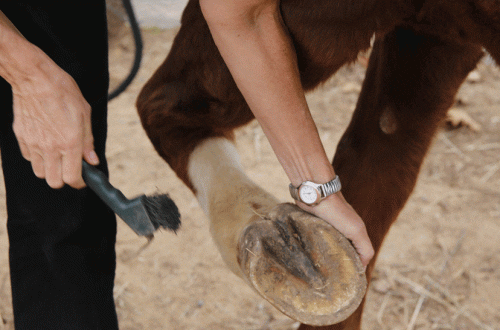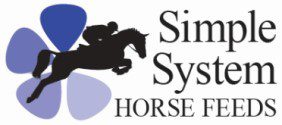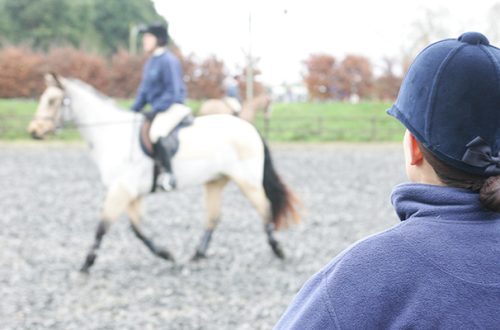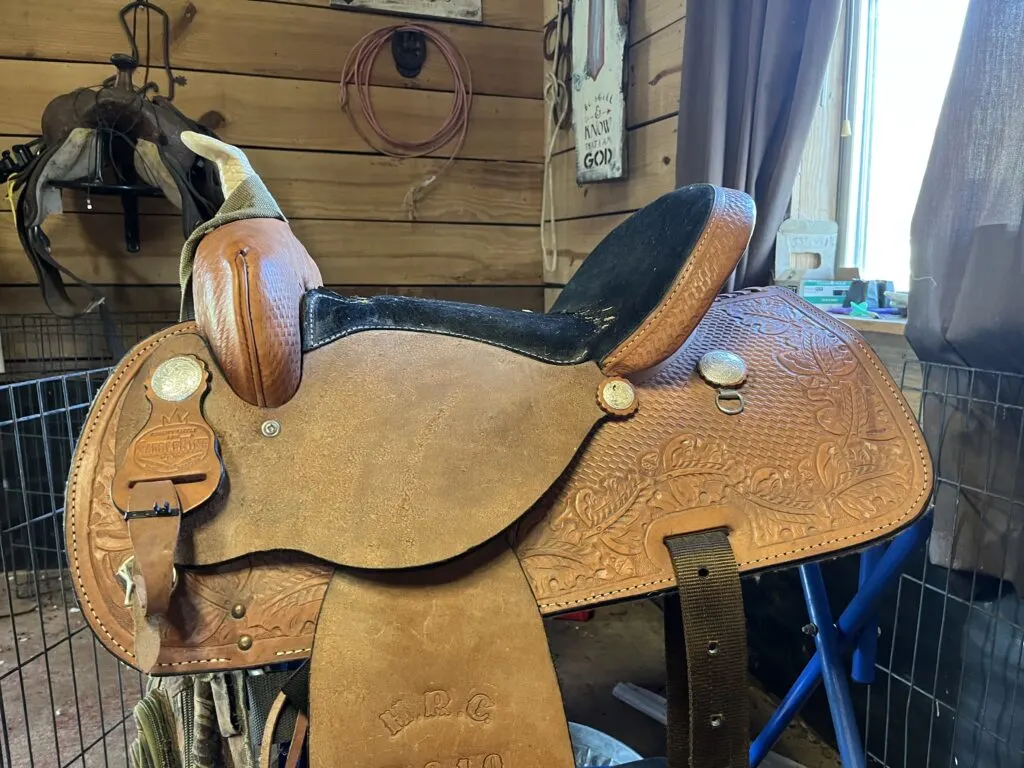
Size matters. Part 2. Choosing a Western Saddle
Rider saddle size
The “human” dimensions of a Western saddle are expressed in inches and represent the length of the saddle from the beginning of the pommel to the seam at the top edge of the pommel.
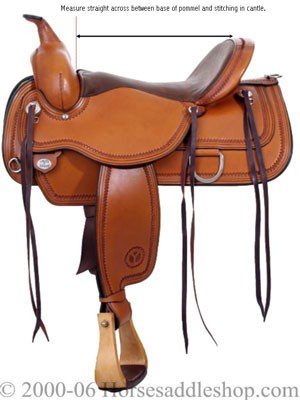
Sizes range from 12-13 inches for children to 18 inches for very large riders, in half-inch increments. Sadly, saddle size doesn’t take into account either pommel or pommel slope or seat angle, although this can determine whether a size 15 or 15,5 saddle fits you.
Approximate ratios of the height and weight of the rider and the size of the saddle are shown in the table.
Rider weight, kg | Rider height, cm | ||
152 – 165 | 166 – 175 | 175+ | |
45 – 57 | 15″ | 15″ | 16″ |
58 – 66 | 15″ | 16″ | 16″ |
67 – 75 | 16″ | 16″ | 16″ |
76 – 84 | 16″ | 16″ | 16″ |
76 – 84 (for pear-shaped women) | 17″ | 16″ | 16″ |
85 – 102 | 17″ | 17″ | 17″ |
103 – 114 | 17″ | 17″ | 17″ |
103 – 114 (for pear-shaped women) | 18″ | 17″ | 17″ |
115+ | 18″ | 18″ | 18″ |
If your height is less than 150 cm, then you will have to order a saddle with shorter fenders. Very tall and thin riders should take leg length into account when choosing a saddle size.
Note also that the size of Western saddles differs from English sizes by 2 inches. So, if you have an English saddle size 17, then in a western you will most likely fit a size 15.
Choosing the size of a western saddle for a horse
Western saddle manufacturers usually offer several tree sizes/types: Quarter Horse, or Regular (sometimes also called Semi Quarter Horse), Full Quarter (FQHB) (sometimes called Wide Tree), Arabian, Gaited Horse, Trees for haflingers, trees for heavy trucks (Draft Horse).
- Quarter Horse BarorSemi Quarter Horse Bar (most of the saddles produced) – the most common tree size. The shelves of this tree have a narrower angle compared to the flatter angle of the FQHB shelves. Such a tree is suitable for an average back, more or less pronounced withers and, often, for crossbred horses (semi-Arabs, appendix quarters and other crossbreeds).
- Lenchik FQHB (fork width is usually 7 inches) is often used for “bulldog” built quarters or for horses with a broad back and very low withers. Generally, FQH shelves have a flatter angle than QH and Semi QH.
- Arabic tree tree suitable for Arabs and has a less wide fork (usually 6½ – 6¾ inches) like the Semi QH, but a flatter cleat angle like the FQHB – or even more. Most often, Arab trees also have shortened shelves.
- Leno for gait horses (Gaited horse) has a higher fork for horses with high withers. Typically, the shelves of such trees expand in front and narrow in the back, so as not to interfere with active shoulder extension. The shelves are also usually more curved in length.
- Trees for haflingers (7½” fork width) are well suited for Haflingers or any other horse with a short back and very flat withers. Such trees have a flatter angle of the shelves, and they are practically not curved in length.
- Lens for heavy trucks (Draft Horse) (shelf width 8 inches) – for large heavy breeds.
Contents Purpose of saddle selection: try to have as much of the surface of the shelves as possible in contact with the horse’s back. |
How much contact is enough? Two circumstances determine the answer to this question:
1.rider weight.The heavier the rider, the more shelf area should fit against the back. Conversely, if the rider is light, less contact can be dispensed with. Remember that you need to divide kilograms into square centimeters.
2.Available shelf space.The smaller and narrower the shelves, the larger their surface should be adjacent to the back. Conversely, if the shelves are long and wide, you can get by with less contact.
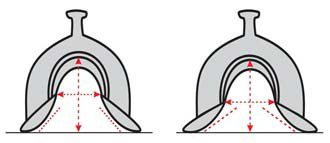
Trees with a narrower and flatter shelf angle. Horizontal distance = fork width.
There are two main areas when choosing a western saddle:
1. Holka.Manufacturers of saddles do not have uniform sizes for the width of the tree. There are general definitions such as half quarter (semiQH) or full quarter (fullQH) that can give a rough idea of what back a given saddle can fit on, but there are no well-defined rules. Each manufacturer has their own idea of what size and shape tree is best for a particular back. When choosing a saddle for your horse, you need to take into account the following:
1.1 Shelf angle
1.1.2. If the slope of the shelves is too narrow, the shelves will be closer to the horse’s back at the bottom and less at the top.
1.1.3. If the angle is too wide, the ledges will only fit at the top and will not touch the horse’s back from below.
The site www.horsesaddleshop.com There are 16 templates available that are handy to use to determine which tree is best for your horse. The templates are grouped into categories based on the angle between the shelves (Normal/Narrow Shelf Angle, Wide Angle and Extra Wide Shelf Angle templates).
1.2 Curvature of the shelves
1.2.1. If the shoulders are straight at the withers, the saddle can move back and also restrict the movement of the shoulder. This is most evident in gaited horses.
1.2.3. The bulge of the shelves is most noticeable in front and behind the saddle. While the front rails can restrict shoulder action, the rear rails can dig into the back if the rider is heavy and sits very deep in the saddle, or if the horse has a short or arched back. Any of these problems can cause scuffs and creases if the saddle legs are not arched enough at the back.
2. Back bend. When choosing a saddle, it is important to pay attention to two aspects regarding the shape of the horse’s back.
2.1 Bridge effect.The bridge effect occurs when the shelves fit against the back front and back, but do not fit in the middle. Usually, with this effect, scuffs or white hair appear in the area of uXNUMXbuXNUMXbthe withers or croup. This is due to one of two reasons:
2.1.1Insufficient bending of the shelves.If the legs are curved to a lesser degree than the horse’s back, a bridge effect will occur.
2.1.2 Short back.If the legs are longer than the horse’s back, a bridge effect will occur. This is most noticeable in Arabians, Paso Finnos, Missouri Foxtrotters, and other short-backed horses.
White hair and scuffs are not always due to the bridge effect, they can also be caused by other causes:
2.1.2.1Tree width– see above.
2.1.2.2 Girth attachment point. As a general rule, most horses don’t need a full binding, preferring a girth position that will shift the tension closer to the center of the saddle or distribute it evenly across the saddle rather than just in front. There are 4 girth attachment options:
2.1.2.2.1Centered. It is located directly in the middle of the saddle.
2.1.2.2.2 3 / 4 “– 1 to 2 inches ahead of center.
2.1.2.2.3 7 / 8 “– the most common mount, the best choice between 3/4 “and full options.
2.1.2.2.4.Full.Girth rings are attached exactly under the forward pommel. These girths are mainly used on rower saddles, due to the increased stress on the saddle horn during roping.
2.2 The “swing” effectis the opposite of the bridge effect. The seesaw effect occurs when the tree legs are curved in length more than the horse’s back, and thus fit snugly against the horse’s back in the middle and are not snug front and back. Usually, if the swing effect is strong, the saddle will rock back and forth on the horse’s back. When such a saddle is tightened with a girth, it will rise strongly above the back from behind. When the rider sits in such a saddle, it will lower the back, which in turn will cause pressure to go from the front of the saddle to its center. This effect is most evident on mules. Keep in mind, however, that the rise of the back of the saddle can be caused not only by the effect of the swing, but also by a fork that is too wide.
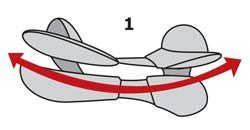 Horizontal bend (roker):degree of curvature of the shelves from front to back
Horizontal bend (roker):degree of curvature of the shelves from front to back
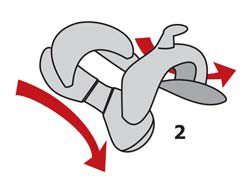 Shelf rotation (twist):the degree of turn of the shelves to the sides
Shelf rotation (twist):the degree of turn of the shelves to the sides
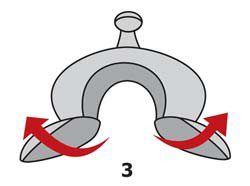 Curvature of shelves in front
Curvature of shelves in front
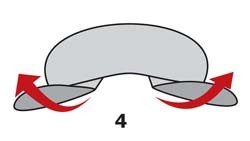 Curvature of the shelves at the back
Curvature of the shelves at the back
The most common questions.
What does white hair say?
Usually, white hair is caused by excessive pressure on any part of the back for a long time. The pressure prevents normal blood flow to the area, which in turn kills the sweat glands and causes white hair to grow. Wool in this place may never recover. By itself, this fact is not a strong cause for concern and does not cause serious long-term damage, as long as you pay attention to this problem. Be sure to contact your veterinarian if abrasions or creases appear.
How about thick saddle pads?
A good saddle pad can help to better fit the saddle on the horse’s back. There are many high-tech models now available that solve minor saddle fitting problems that are definitely worth using. However, using saddle pads to remove scuffs and bumps is a bad idea. For example, if the saddle is too narrow, a thick saddle pad will make it even narrower, and therefore put even more pressure on the back.
Translation by Ekaterina Lomeiko (Sara) (based on materials from the site Horsesaddleshop.com).
Material posted with the permission of the copyright holder RideWest.ru



